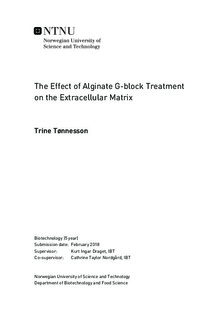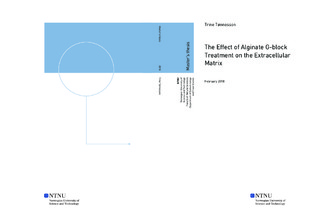| dc.contributor.advisor | Draget, Kurt Ingar | |
| dc.contributor.advisor | Taylor Nordgård, Cathrine | |
| dc.contributor.author | Tønnesson, Trine | |
| dc.date.accessioned | 2018-04-20T14:00:28Z | |
| dc.date.available | 2018-04-20T14:00:28Z | |
| dc.date.created | 2018-02-16 | |
| dc.date.issued | 2018 | |
| dc.identifier | ntnudaim:14441 | |
| dc.identifier.uri | http://hdl.handle.net/11250/2495354 | |
| dc.description.abstract | Dense extracellular matrix and alterations of extracellular matrix are two of the hallmarks of solid tumors. The resulting highly fibrotic extracellular matrix is associated with several types of cancer. These solid tumors can pose a physiological resistance to cancer treatment, in part by preventing delivery of blood-borne drugs to cancer cells. This in turn causes a high mortality rate for solid tumors. RiXOVA is an anti-cancer drug candidate based on G-block technology that is hypothesized to target the extracellular matrix. Experimental in vivo studies on pancre- atic cancer xenografted in a mouse model treated with G-block has shown a reduction in tumor growth both with G-block a single vehicle and in combination with the chemotherapy Gemc- itabine. A hypothesized mode of action concerning G-block is that G-blocks are able to reduce the barrier created by the extracellular matrix in certain cancer types (e.g breast and pancreatic cancer) easing the delivery of drugs into the tumor microenvironment and increasing the drug bioavailability.
The aim of this thesis is to investigate the effect of G-block on collagen IV, fibronectin and α- smooth muscle actin in a xenografted pancreatic tumor model by using immunohistochemistry and attempting to quantify the results obtained with ImmunoRatio. In addition to that rheological properties (e.g gelling kinetic, setting time and deformation response) of collagen gel with and without added G-block were investigated to elucidate possible effects of G-block on collagen.
Within immunohistochemistry the addition of G-block demonstrated a significant difference in amount of fibronectin, quantified as a DAB+/nuclear staining, for mice that received 10 doses of G-block. There were no significant differences for collagen IV or α-smooth muscle actin in G-block treated tumor versus control tumor. Regarding rheology, addition of G-block in the collagen gel caused a shift in the gelling kinetics. There was a significant difference in the tem- perature in which the elastic modulus was at 20% of its maximum value for collagen gel with G-block added relative to collagen gel without G-block added. G-block did not influence the setting of collagen as both collagen with and without G-block appeared to not reach apparent equilibrium during the isothermal hold time. Collagen gels both with and without G-block ap- peared to exhibit a frequency dependence at 1-10 Hz in the frequency sweep suggesting that the collagen gel could be a physical gel. G-block at a 5.00 mg/ml concentration appeared to affect the strength of the gel causing a potential shift from a weak gel to a strong gel. | |
| dc.language | eng | |
| dc.publisher | NTNU | |
| dc.subject | Bioteknologi (5 årig), Biokjemi og biopolymerkjemi | |
| dc.title | The Effect of Alginate G-block Treatment on the Extracellular Matrix | |
| dc.type | Master thesis | |

